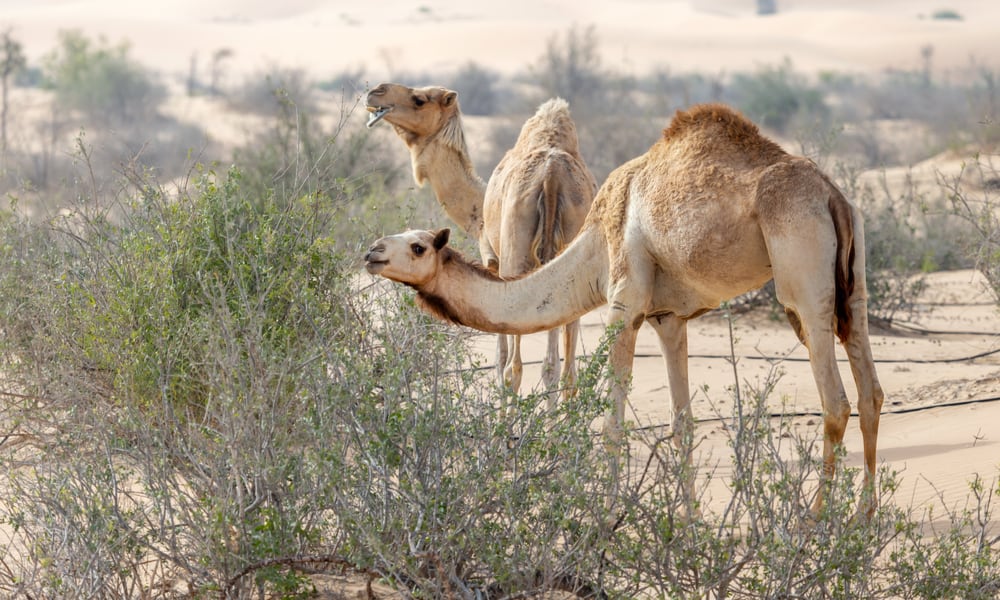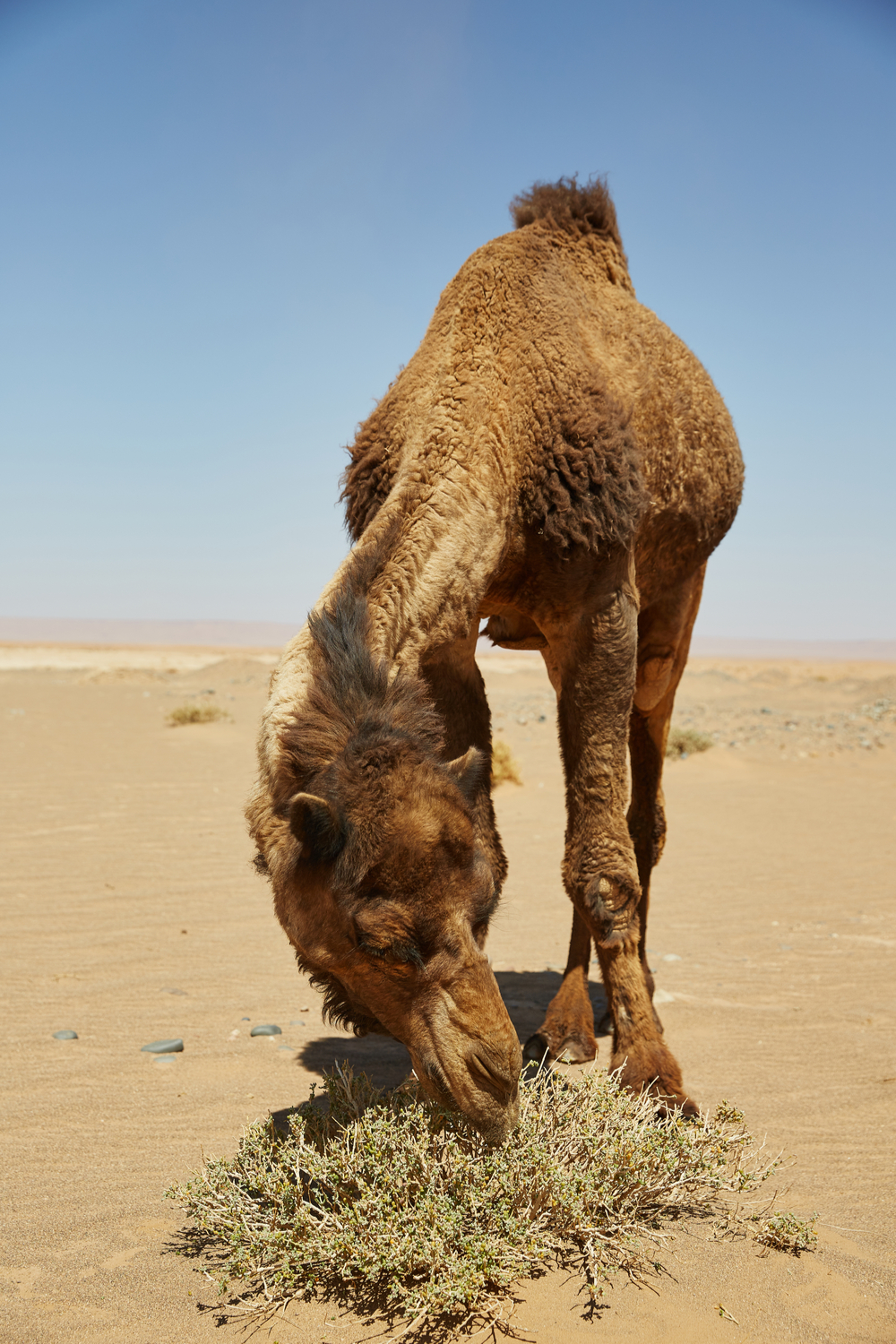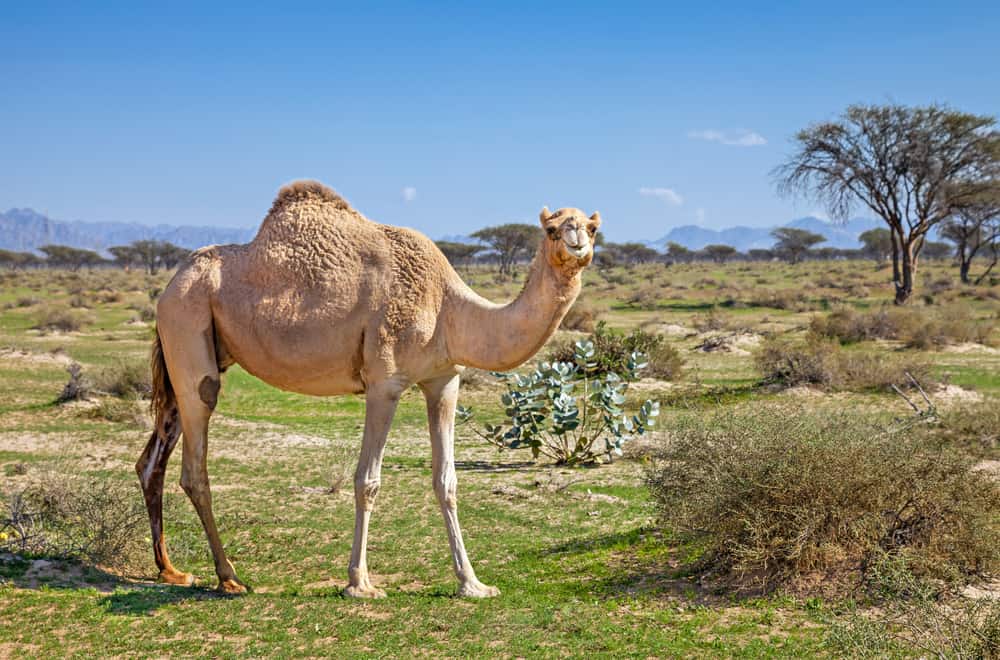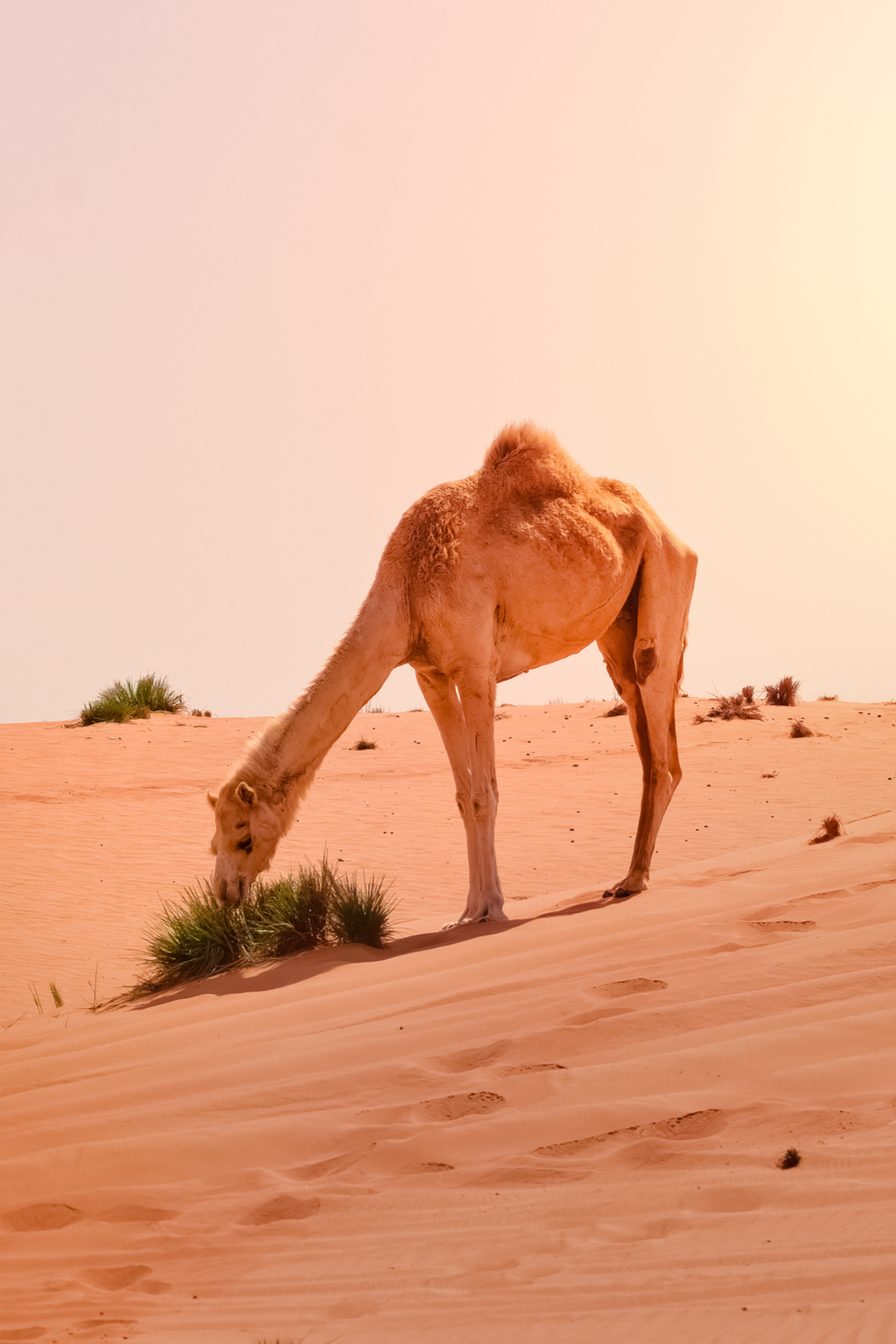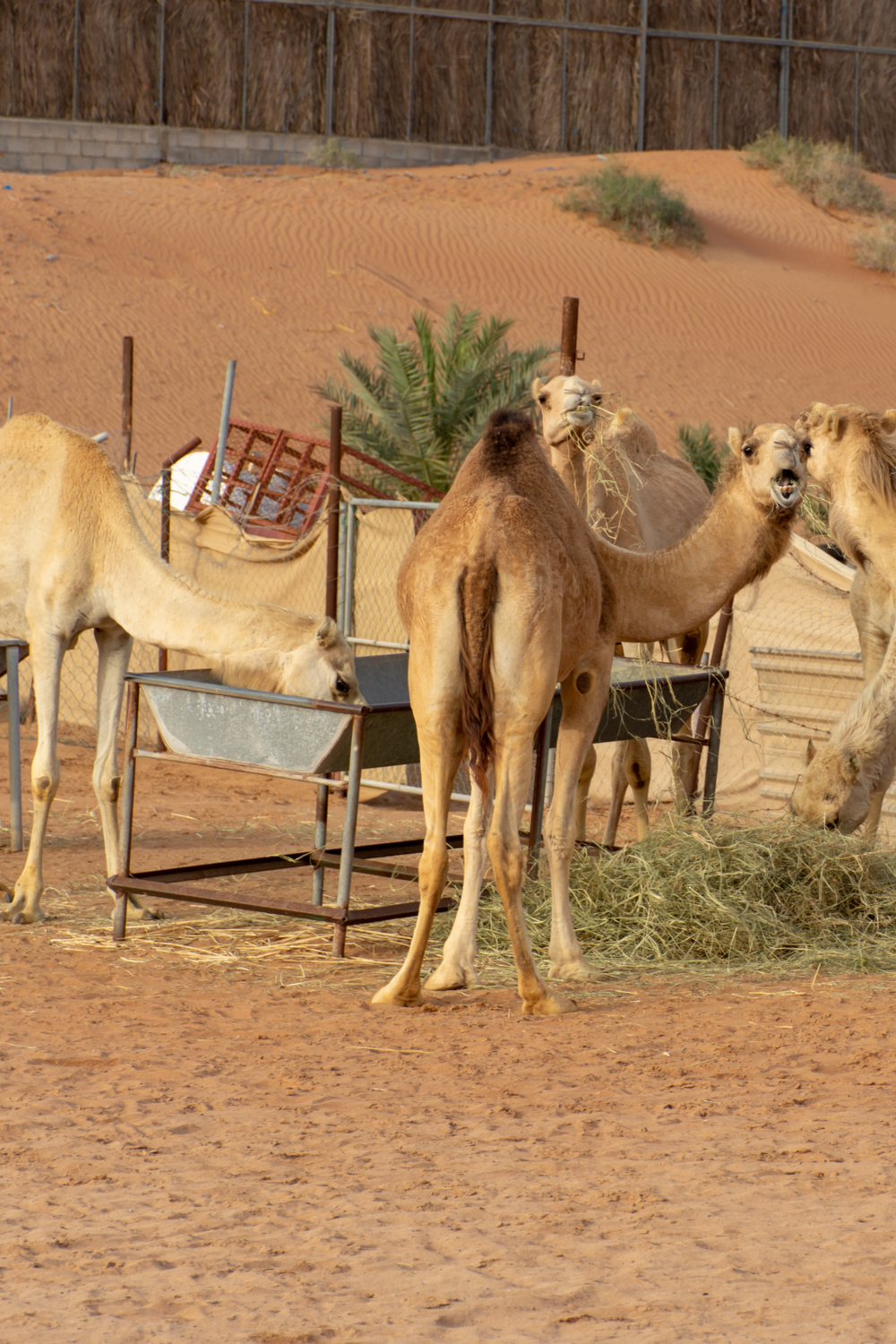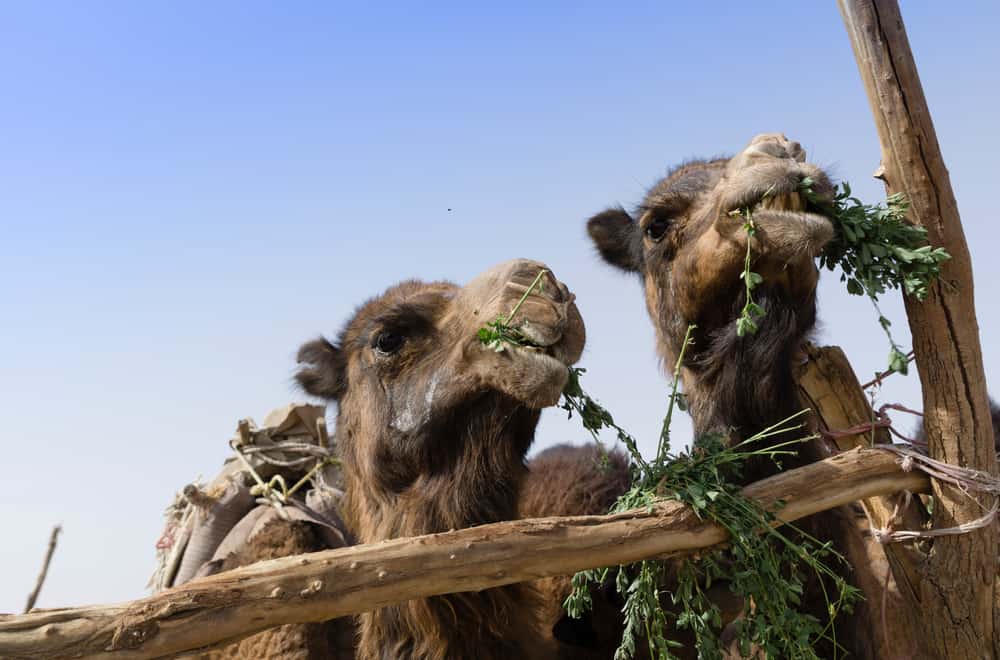Known as the “ships of the desert”, camels have played a vital role in trade and transport throughout North Africa, the Middle East, Central Asia and the Far East since they were first domesticated around three millennia ago.
This is mainly due to their many adaptations that make them extremely resistant to harsh desert conditions, and to give you an idea of how well-suited they are to this kind of life, in this post we answer the question, what do camels eat?
Habitats and biology
There are currently three different species of camel in the world. 96% of the world’s camel population is made up of one-humped dromedaries while a further 4% is made up of two-humped Bactrians.
The third species is the wild Bactrian, which is now considered critically endangered – there are currently thought to be only around 1,000 individuals left in the wild, living in isolated pockets in remote desert regions of China and Mongolia.
Although wild Bactrians were once thought to be feral animals descended from escaped Bactrians, it is now known that they are a truly wild species that has never been domesticated. As such, they are now considered a separate species from domesticated Bactrian camels.
Dromedaries, on the other hand, are an entirely domesticated species. No wild dromedaries exist anywhere in the world, although a population of feral animals exists in Australia, where they are an introduced species.
Camels have long been prized for their almost legendary performance as a pack animal – there are few animals in the world that can carry as much weight over such long distances while requiring so little maintenance as a Bactrian camel, and the dromedary is not far behind.
However, as well as their usefulness for transport in challenging desert conditions, they can also provide wool, milk, meat and hides for the people who keep them.
Sometimes, even their dried dung is collected since it can be burned, providing heat for warmth as well as cooking.
Desert adaptations
All three species of camel display some amazing adaptations for life in the desert. Here are some of the most important.
A dromedary can survive by drinking water only once every ten days, even in extremely hot conditions. When they drink, a 600kg (1,320lb) camel can drink 200 liters (53 gallons) of water in three minutes – something that would kill just about any other animal on the planet.
Camels rarely sweat, and they can also survive losing up to 25% of their body mass in water. Most other animals will die from cardiac failure after losing only 12-14%.
They can also withstand extreme variations of temperature – in parts of Bactrian camels’ natural range, temperatures can vary between -40°C (-40°F) in the depths of winter to 40°C (104°F) during the hottest part of summer.
However, perhaps the best-known adaptation is their famous hump. Many people believe that camels’ humps are used to store water, but in reality, they store energy as fat. This allows them to survive for long periods without eating – sometimes as long as a month or more.
To learn more about camels’ humps and how they got them, you can check out this fascinating video that tells you all about it.
Camels are ruminants, which means they have four stomachs for digesting tough vegetation. After swallowing food, they will regurgitate it to chew it a second time, allowing them to process tough foods and extract the maximum amount of nutrition from them.
This allows them to consume a wide range of foods that other animals wouldn’t be able to eat – so let’s have a look at that now.
If you want to learn a bit more about some of the other adaptations that allow camels to survive in deserts, you can also check out this video for more details.
What do camels like to eat most?
Since food is scarce in their natural desert habitat, camels have developed the ability to survive on almost anything they can find.
Since most of them are domesticated animals, their diet depends largely on what their owners provide them with. However, when in the desert, they are often left to forage for themselves, munching up whatever they can find.
So what do camels like to eat most?
Dromedaries and Bactrians in the desert
Working camels are often left to find food for themselves, and they aren’t fussy eaters – they will eat just about anything they can find, and the things camels like to eat most include some of the following:
- Grasses
When a camel has access to grass, it will spend its time grazing until it’s time to move on.
- Leaves and twigs of shrubs and trees
Camels will eat the leaves and even twigs of any shrubs and trees they come across.
- All kinds of desert plants
Hardy desert plants are also on the menu for camels. The lining of a camel’s mouth is thick and leathery, which protects them from spiny desert plants that other animals can’t eat.
Camels are also content to consume saltbush, again, something that other animals generally won’t touch.
- Trees like poplars and willows
When camels reach oases, more nutritious vegetation is often available, and they will eat twigs and leaves from trees like poplar and willow.
- Fish
Camels are not 100% vegetarian, and they will eat fish when hungry if the opportunity presents itself. This willingness to eat almost anything shows how well they are adapted to surviving in the harshest of environments.
- Salt
Salt is an important part of a camel’s diet, and they can’t survive without it. They need around eight times more than other livestock animals such as sheep or cattle.
- Water
Camels are incredibly well adapted to conserving water, so they don’t need to drink often. However, when they have the chance, they can consume prodigious amounts if they are thirsty.
If water is readily available, they will drink more moderate amounts daily. On the other hand, when there is plenty of lush vegetation to eat, they may go several months without drinking since they get enough water simply from the food they eat.
Dromedaries and Bactrians in captivity
Animals kept in captivity in zoos – as opposed to working camels – eat what they are given by their keepers. Here’s the kind of thing they usually receive:
- Bermuda and Sudan hay
The bulk of a captive camel’s diet is made up of hay like Bermuda or Sudan hay.
- Herbivore pellets
Camels may be given herbivore pellets to supplement their diets.
Wild Bactrians
Wild Bactrians are similar to domesticated camels in that they are unfussy eaters that will consume almost anything they come across. However, they have one unique adaptation that makes them even hardier than their domesticated cousins:
- Can survive on water that’s saltier than seawater
The wild Bactrian is possibly the only land mammal – including the domesticated Bactrian – that can survive on water that is saltier than seawater. Drinking water this salty would quickly kill any other mammal, which just shows how tough these animals are!
Foods to avoid
There’s not much a camel won’t eat, and they have strong stomachs that are hard to upset. However, some plants are poisonous to camels, so they should be avoided.
- Poisonous plants
Working camels that are allowed to forage for themselves instinctively know which plants make them sick and naturally avoid them.
However, when taken to new areas with unfamiliar vegetation, they have been known to consume plants that are poisonous to them, which can then make them ill.
However, once they consume something that makes them sick, once they recover, they quickly learn to not eat the same plant again.
Tips for feeding a camel
As you have probably realized by now, camels can eat a wide range of plants and are not bothered by tough vegetation, spines or twigs.
All you need to do to keep a camel healthy is to make sure it has plenty of vegetation to eat and to make sure it also has enough water to drink. Beyond this, they also require a certain amount of salt in their diet, and this is something important to remember.
Otherwise, camels are incredibly hardy animals, and working camels in the desert are usually largely left to fend for themselves, which means they are easy animals to keep in this respect.
Having said that, a fully grown dromedary stands at 1.85 m (6 ft 1 in) at the shoulder and can weigh 300 to 600kg (660 to 1,320lbs) while Bactrians are even taller and can weigh up to 1000kg (2,200lbs).
This means it’s important to make sure you provide enough food for such a large animal.
A beautiful, majestic animal
In their own way, camels are beautiful, majestic animals, and without them, perhaps much of the history of large swathes of the world where they are found would have been quite different.
They are tough and hardy animals that are perfectly adapted to life in some of the harshest environments on the planet, and we hope that having read our post, you now know a bit more about this enigmatic, fascinating creature.
